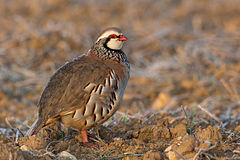Red-legged partridge
| Red-legged partridge | |
|---|---|
 |
|
| Scientific classification | |
| Kingdom: | Animalia |
| Phylum: | Chordata |
| Class: | Aves |
| Order: | Galliformes |
| Family: | Phasianidae |
| Subfamily: | Perdicinae |
| Genus: | Alectoris |
| Species: | A. rufa |
| Binomial name | |
|
Alectoris rufa (Linnaeus, 1758) |
|
The red-legged partridge (Alectoris rufa) is a gamebird in the pheasant family Phasianidae of the order Galliformes, gallinaceous birds. It is sometimes known as French partridge, to distinguish it from the English or grey partridge. The genus name is from Ancient Greek alektoris a farmyard chicken, and rufa is Latin for red or rufous.
It is a rotund bird, with a light brown back, grey breast and buff belly. The face is white with a black gorget. It has rufous-streaked flanks and red legs. When disturbed, it prefers to run rather than fly, but if necessary it flies a short distance on rounded wings.
This is a seed-eating species, but the young in particular take insects as an essential protein supply. The call is a three-syllable ka-chu-chu.
This partridge breeds naturally in southwestern Europe (France, Iberia and northwest Italy). It has become naturalised in flat areas of England and Wales, where it was introduced as a game species, and has been seen breeding as far north as Cumbria and eastern Yorkshire and the western Isle of Man. It is replaced in southeastern Europe by the very similar rock partridge (Alectoris graeca). It is a non-migratory terrestrial species, which forms flocks outside the breeding season.
This species breeds on dry lowlands, such as farmland and open stony areas, laying its eggs in a ground nest.
There are three recognized subspecies:
Adult red-legged partridges are sandy-brown above, pinkish-buff on the belly, and pale grey on the breast, with a prominent gorget of black streaking, bold rufous and black flank-bars, a cream throat, pink legs, and a red bill and eye ring.
...
Wikipedia

